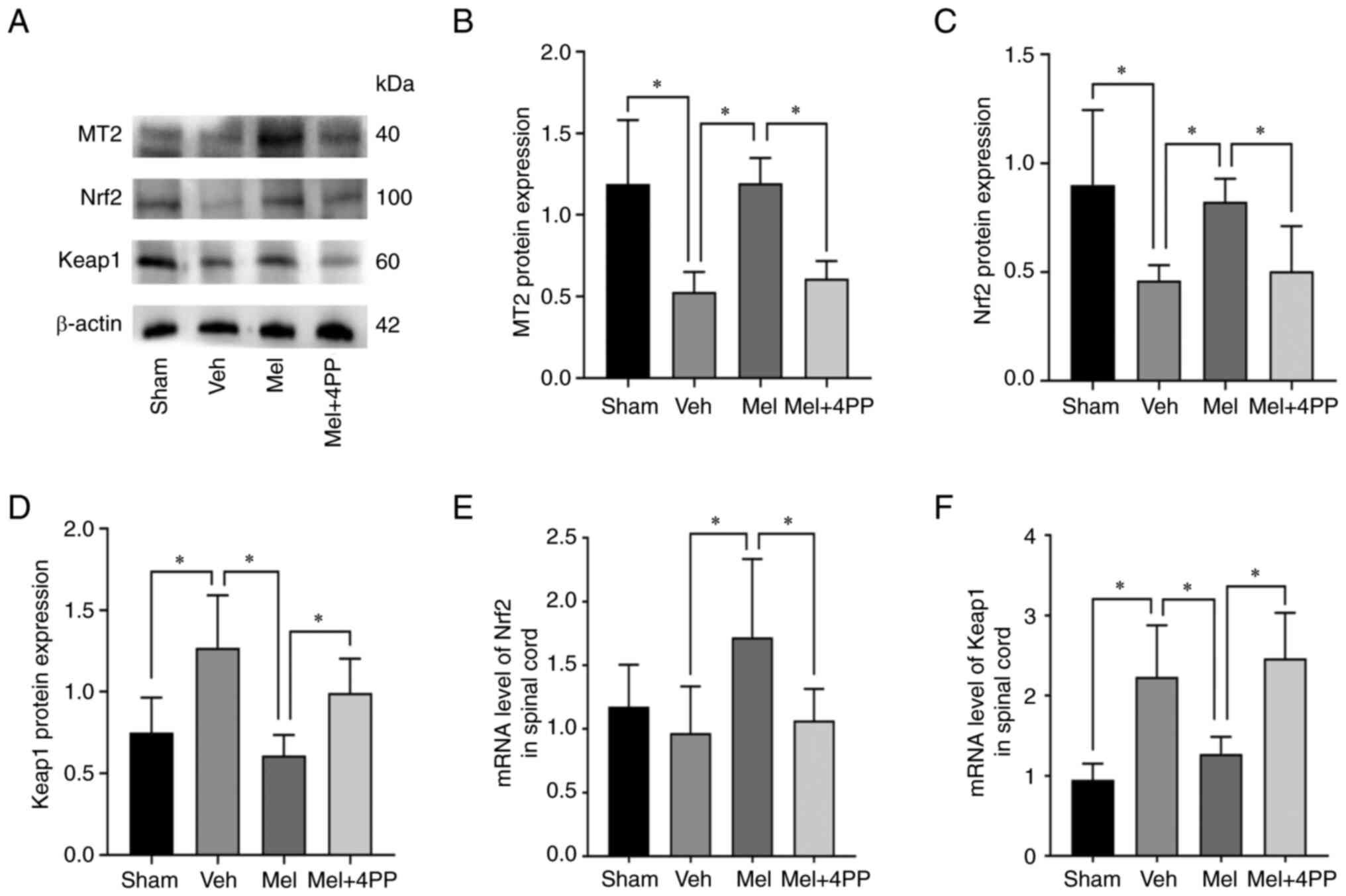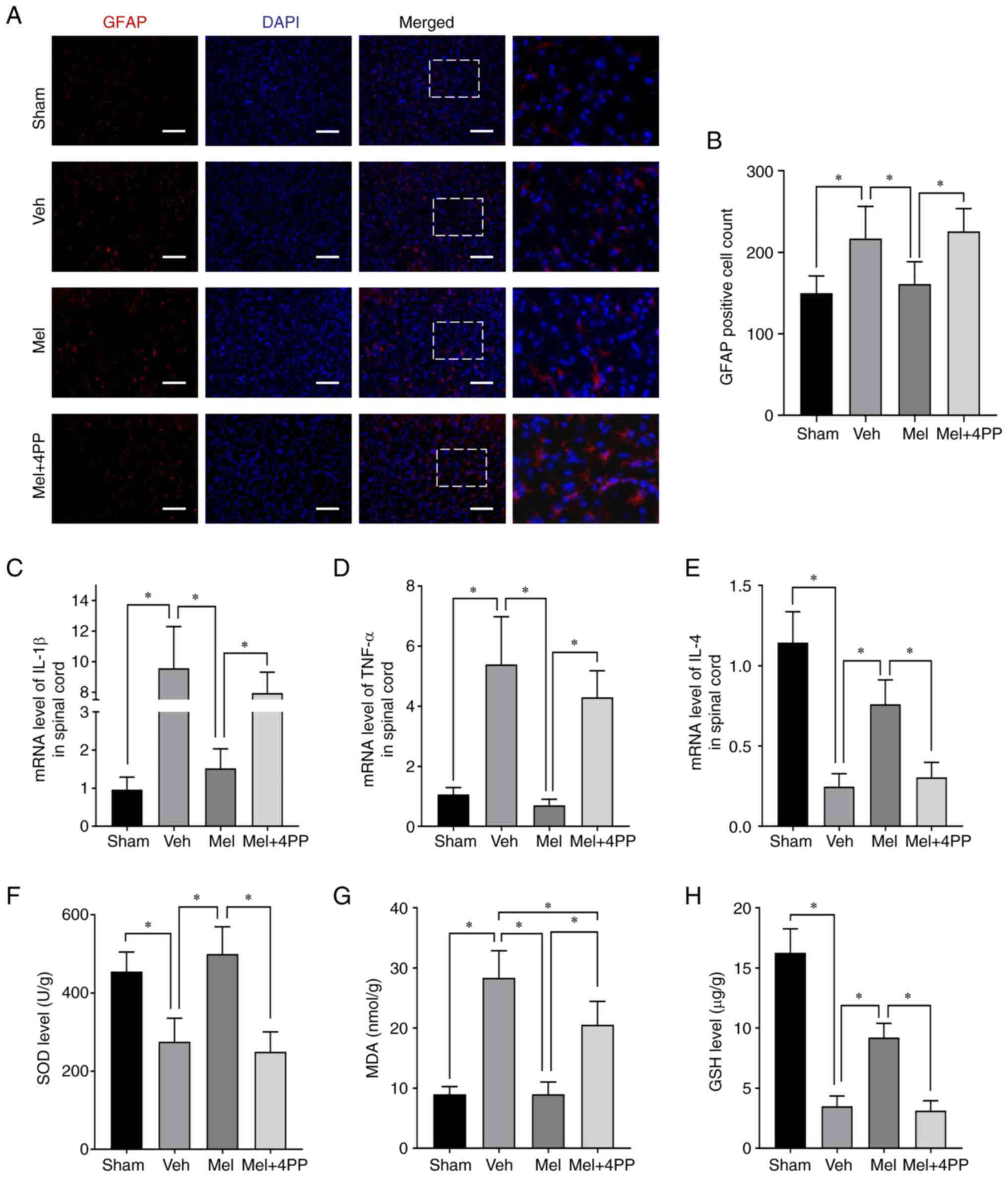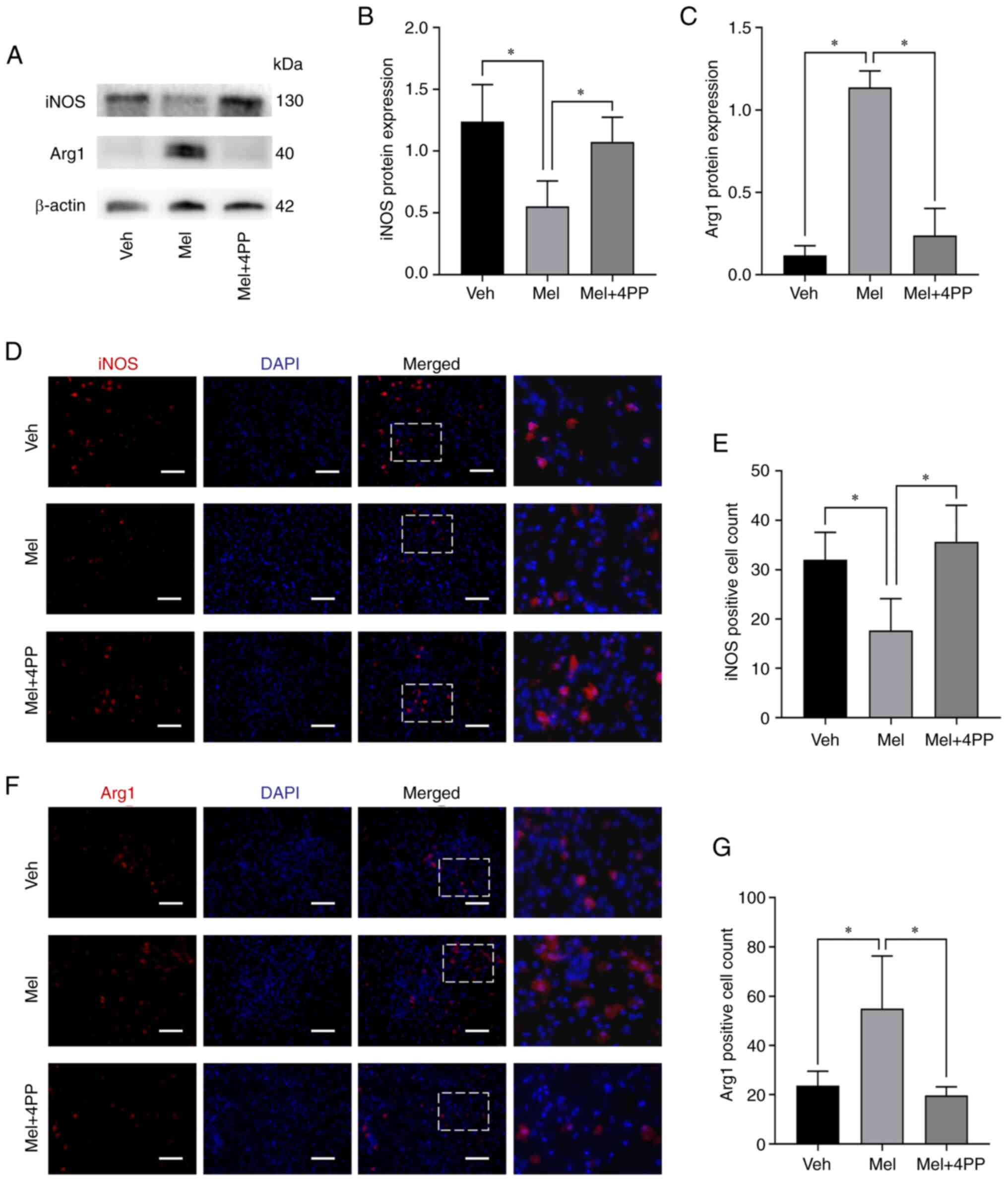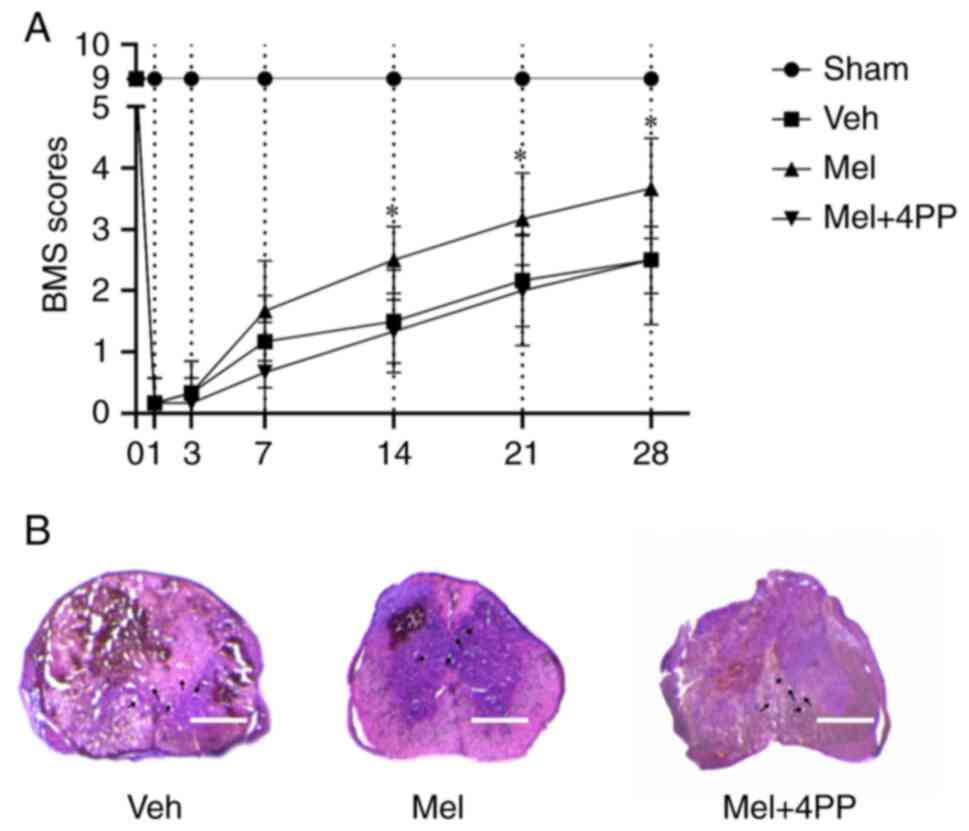|
1
|
Zipser CM, Cragg JJ, Guest JD, Fehlings
MG, Jutzeler CR, Anderson AJ and Curt A: Cell-based and
stem-cell-based treatments for spinal cord injury: Evidence from
clinical trials. Lancet Neurol. 21:659–670. 2022.PubMed/NCBI View Article : Google Scholar
|
|
2
|
Jiang B, Sun D, Sun H, Ru X, Liu H, Ge S,
Fu J and Wang W: Prevalence, incidence, and external causes of
traumatic spinal cord injury in China: A nationally representative
cross-sectional survey. Front Neurol. 12(784647)2022.PubMed/NCBI View Article : Google Scholar
|
|
3
|
Fleming JC, Norenberg MD, Ramsay DA,
Dekaban GA, Marcillo AE, Saenz AD, Pasquale-Styles M, Dietrich WD
and Weaver LC: The cellular inflammatory response in human spinal
cords after injury. Brain. 129:3249–3269. 2006.PubMed/NCBI View Article : Google Scholar
|
|
4
|
Routhe LJ and Moos T: Handling iron in
restorative neuroscience. Neural Regen Res. 10:1558–1559.
2015.PubMed/NCBI View Article : Google Scholar
|
|
5
|
Fan B, Wei Z, Yao X, Shi G, Cheng X, Zhou
X, Zhou H, Ning G, Kong X and Feng S: Microenvironment imbalance of
spinal cord injury. Cell Transplant. 27:853–866. 2018.PubMed/NCBI View Article : Google Scholar
|
|
6
|
Higgins LG, Kelleher MO, Eggleston IM,
Itoh K, Yamamoto M and Hayes JD: Transcription factor Nrf2 mediates
an adaptive response to sulforaphane that protects fibroblasts in
vitro against the cytotoxic effects of electrophiles, peroxides and
redox-cycling agents. Toxicol Appl Pharmacol. 237:267–280.
2009.PubMed/NCBI View Article : Google Scholar
|
|
7
|
Sajadimajd S and Khazaei M: Oxidative
stress and cancer: The role of Nrf2. Curr Cancer Drug Targets.
18:538–557. 2018.PubMed/NCBI View Article : Google Scholar
|
|
8
|
Wang J, Fields J, Zhao C, Langer J,
Thimmulappa RK, Kensler TW, Yamamoto M, Biswal S and Doré S: Role
of Nrf2 in protection against intracerebral hemorrhage injury in
mice. Free Radic Biol Med. 43:408–414. 2007.PubMed/NCBI View Article : Google Scholar
|
|
9
|
Chang CF, Cho S and Wang J:
(-)-Epicatechin protects hemorrhagic brain via synergistic Nrf2
pathways. Ann Clin Transl Neurol. 1:258–271. 2014.PubMed/NCBI View
Article : Google Scholar
|
|
10
|
Dodson M, Castro-Portuguez R and Zhang DD:
NRF2 plays a critical role in mitigating lipid peroxidation and
ferroptosis. Redox Biol. 23(101107)2019.PubMed/NCBI View Article : Google Scholar
|
|
11
|
Zhang X, Wu Q, Lu Y, Wan J, Dai H, Zhou X,
Lv S, Chen X, Zhang X, Hang C and Wang J: Cerebroprotection by
salvianolic acid B after experimental subarachnoid hemorrhage
occurs via Nrf2- and SIRT1-dependent pathways. Free Radic Biol Med.
124:504–516. 2018.PubMed/NCBI View Article : Google Scholar
|
|
12
|
Lan X, Han X, Li Q and Wang J:
(-)-Epicatechin, a natural flavonoid compound, protects astrocytes
against hemoglobin toxicity via Nrf2 and AP-1 signaling pathways.
Mol Neurobiol. 54:7898–7907. 2017.PubMed/NCBI View Article : Google Scholar
|
|
13
|
Ulasov AV, Rosenkranz AA, Georgiev GP and
Sobolev AS: Nrf2/Keap1/ARE signaling: Towards specific regulation.
Life Sci. 291(120111)2022.PubMed/NCBI View Article : Google Scholar
|
|
14
|
Wang J, Jiang C, Zhang K, Lan X, Chen X,
Zang W, Wang Z, Guan F, Zhu C, Yang X, et al: Melatonin receptor
activation provides cerebral protection after traumatic brain
injury by mitigating oxidative stress and inflammation via the Nrf2
signaling pathway. Free Radic Biol Med. 131:345–355.
2019.PubMed/NCBI View Article : Google Scholar
|
|
15
|
Suzuki T and Yamamoto M: Stress-sensing
mechanisms and the physiological roles of the Keap1-Nrf2 system
during cellular stress. J Biol Chem. 292:16817–16824.
2017.PubMed/NCBI View Article : Google Scholar
|
|
16
|
Ren H, Han R, Liu X, Wang L, Koehler RC
and Wang J: Nrf2-BDNF-TrkB pathway contributes to cortical
hemorrhage-induced depression, but not sex differences. J Cereb
Blood Flow Metab. 41:3288–3301. 2021.PubMed/NCBI View Article : Google Scholar
|
|
17
|
Jia P, Wang J, Ren X, He J, Wang S, Xing
Y, Chen D, Zhang X, Zhou S, Liu X, et al: An enriched environment
improves long-term functional outcomes in mice after intracerebral
hemorrhage by mechanisms that involve the Nrf2/BDNF/glutaminase
pathway. J Cereb Blood Flow Metab. 43:694–711. 2023.PubMed/NCBI View Article : Google Scholar
|
|
18
|
Liu Z, Gan L, Luo D and Sun C: Melatonin
promotes circadian rhythm-induced proliferation through
Clock/histone deacetylase 3/c-Myc interaction in mouse adipose
tissue. J Pineal Res. 62:2017.PubMed/NCBI View Article : Google Scholar
|
|
19
|
Rosales-Corral SA, Acuña-Castroviejo D,
Coto-Montes A, Boga JA, Manchester LC, Fuentes-Broto L, Korkmaz A,
Ma S, Tan DX and Reiter RJ: Alzheimer's disease: Pathological
mechanisms and the beneficial role of melatonin. J Pineal Res.
52:167–202. 2012.PubMed/NCBI View Article : Google Scholar
|
|
20
|
Naskar A, Prabhakar V, Singh R, Dutta D
and Mohanakumar KP: Melatonin enhances L-DOPA therapeutic effects,
helps to reduce its dose, and protects dopaminergic neurons in
1-methyl-4-phenyl-1,2,3,6-tetrahydropyridine-induced Parkinsonism
in mice. J Pineal Res. 58:262–274. 2015.PubMed/NCBI View Article : Google Scholar
|
|
21
|
Hardeland R: Melatonin: Signaling
mechanisms of a pleiotropic agent. Biofactors. 35:183–192.
2009.PubMed/NCBI View
Article : Google Scholar
|
|
22
|
Liu J, Clough SJ, Hutchinson AJ,
Adamah-Biassi EB, Popovska-Gorevski M and Dubocovich ML: MT1 and
MT2 melatonin receptors: A therapeutic perspective. Annu Rev
Pharmacol Toxicol. 56:361–383. 2016.PubMed/NCBI View Article : Google Scholar
|
|
23
|
Zhang J, Cheng T, Chen Y, Gao F, Guan F
and Yao M: A chitosan-based thermosensitive scaffold loaded with
bone marrow-derived mesenchymal stem cells promotes motor function
recovery in spinal cord injured mice. Biomed Mater.
15(035020)2020.PubMed/NCBI View Article : Google Scholar
|
|
24
|
Han X, Zhao X, Lan X, Li Q, Gao Y, Liu X,
Wan J, Yang Z, Chen X, Zang W, et al: 20-HETE synthesis inhibition
promotes cerebral protection after intracerebral hemorrhage without
inhibiting angiogenesis. J Cereb Blood Flow Metab. 39:1531–1543.
2019.PubMed/NCBI View Article : Google Scholar
|
|
25
|
Lan X, Han X, Li Q, Li Q, Gao Y, Cheng T,
Wan J, Zhu W and Wang J: Pinocembrin protects hemorrhagic brain
primarily by inhibiting toll-like receptor 4 and reducing M1
phenotype microglia. Brain Behav Immun. 61:326–339. 2017.PubMed/NCBI View Article : Google Scholar
|
|
26
|
Singhal NK, Srivastava G, Patel DK, Jain
SK and Singh MP: Melatonin or silymarin reduces maneb- and
paraquat-induced Parkinson's disease phenotype in the mouse. J
Pineal Res. 50:97–109. 2011.PubMed/NCBI View Article : Google Scholar
|
|
27
|
Kang JW and Lee SM: Melatonin inhibits
type 1 interferon signaling of toll-like receptor 4 via heme
oxygenase-1 induction in hepatic ischemia/reperfusion. J Pineal
Res. 53:67–76. 2012.PubMed/NCBI View Article : Google Scholar
|
|
28
|
Ding K, Wang H, Xu J, Li T, Zhang L, Ding
Y, Zhu L, He J and Zhou M: Melatonin stimulates antioxidant enzymes
and reduces oxidative stress in experimental traumatic brain
injury: The Nrf2-ARE signaling pathway as a potential mechanism.
Free Radic Biol Med. 73:1–11. 2014.PubMed/NCBI View Article : Google Scholar
|
|
29
|
El-Sokkary GH, Nafady AA and Shabash EH:
Melatonin administration ameliorates cadmium-induced oxidative
stress and morphological changes in the liver of rat. Ecotoxicol
Environ Saf. 73:456–463. 2010.PubMed/NCBI View Article : Google Scholar
|
|
30
|
Chern CM, Liao JF, Wang YH and Shen YC:
Melatonin ameliorates neural function by promoting endogenous
neurogenesis through the MT2 melatonin receptor in ischemic-stroke
mice. Free Radic Biol Med. 52:1634–1647. 2012.PubMed/NCBI View Article : Google Scholar
|
|
31
|
Basso DM, Fisher LC, Anderson AJ, Jakeman
LB, McTigue DM and Popovich PG: Basso Mouse Scale for locomotion
detects differences in recovery after spinal cord injury in five
common mouse strains. J Neurotrauma. 23:635–659. 2006.PubMed/NCBI View Article : Google Scholar
|
|
32
|
Guo L, Lv J, Huang YF, Hao DJ and Liu JJ:
Bioinformatics analyses of differentially expressed genes
associated with spinal cord injury: A microarray-based analysis in
a mouse model. Neural Regen Res. 14:1262–1270. 2019.PubMed/NCBI View Article : Google Scholar
|
|
33
|
Cheng T, Wang W, Li Q, Han X, Xing J, Qi
C, Lan X, Wan J, Potts A, Guan F and Wang J: Cerebroprotection of
flavanol (-)-epicatechin after traumatic brain injury via
Nrf2-dependent and -independent pathways. Free Radic Biol Med.
92:15–28. 2016.PubMed/NCBI View Article : Google Scholar
|
|
34
|
Han X, Li Q, Lan X, El-Mufti L, Ren H and
Wang J: Microglial depletion with clodronate liposomes increases
proinflammatory cytokine levels, induces astrocyte activation, and
damages blood vessel integrity. Mol Neurobiol. 56:6184–6196.
2019.PubMed/NCBI View Article : Google Scholar
|
|
35
|
Cheng T, Yang B, Li D, Ma S, Tian Y, Qu R,
Zhang W, Zhang Y, Hu K, Guan F and Wang J: Wharton's jelly
transplantation improves neurologic function in a rat model of
traumatic brain injury. Cell Mol Neurobiol. 35:641–649.
2015.PubMed/NCBI View Article : Google Scholar
|
|
36
|
Li Q, Lan X, Han X and Wang J: Expression
of Tmem119/Sall1 and Ccr2/CD69 in FACS-sorted microglia- and
monocyte/macrophage-enriched cell populations after intracerebral
hemorrhage. Front Cell Neurosci. 12(520)2019.PubMed/NCBI View Article : Google Scholar
|
|
37
|
Livak KJ and Schmittgen TD: Analysis of
relative gene expression data using real-time quantitative PCR and
the 2(-Delta Delta C(T)) method. Methods. 25:402–408.
2001.PubMed/NCBI View Article : Google Scholar
|
|
38
|
Kroner A, Greenhalgh AD, Zarruk JG, Passos
Dos Santos R, Gaestel M and David S: TNF and increased
intracellular iron alter macrophage polarization to a detrimental
M1 phenotype in the injured spinal cord. Neuron. 83:1098–1116.
2014.PubMed/NCBI View Article : Google Scholar
|
|
39
|
Fenn AM, Henry CJ, Huang Y, Dugan A and
Godbout JP: Lipopolysaccharide-induced interleukin (IL)-4
receptor-α expression and corresponding sensitivity to the M2
promoting effects of IL-4 are impaired in microglia of aged mice.
Brain Behav Immun. 26:766–777. 2012.PubMed/NCBI View Article : Google Scholar
|
|
40
|
Barbiellini Amidei C, Salmaso L, Bellio S
and Saia M: Epidemiology of traumatic spinal cord injury: A large
population-based study. Spinal Cord. 60:812–819. 2022.PubMed/NCBI View Article : Google Scholar
|
|
41
|
Welp A, Manz B and Peschke E: Development
and validation of a high throughput direct radioimmunoassay for the
quantitative determination of serum and plasma melatonin
(N-acetyl-5-methoxytryptamine) in mice. J Immunol Methods. 358:1–8.
2010.PubMed/NCBI View Article : Google Scholar
|
|
42
|
Chen LY, Tiong C, Tsai CH, Liao WC, Yang
SF, Youn SC, Mai FD and Chang HM: Early-life sleep deprivation
persistently depresses melatonin production and bio-energetics of
the pineal gland: Potential implications for the development of
metabolic deficiency. Brain Struct Funct. 220:663–676.
2015.PubMed/NCBI View Article : Google Scholar
|
|
43
|
Ebisawa T, Karne S, Lerner MR and Reppert
SM: Expression cloning of a high-affinity melatonin receptor from
Xenopus dermal melanophores. Proc Natl Acad Sci USA. 91:6133–6137.
1994.PubMed/NCBI View Article : Google Scholar
|
|
44
|
Reppert SM, Godson C, Mahle CD, Weaver DR,
Slaugenhaupt SA and Gusella JF: Molecular characterization of a
second melatonin receptor expressed in human retina and brain: The
Mel1b melatonin receptor. Proc Natl Acad Sci USA. 92:8734–8738.
1995.PubMed/NCBI View Article : Google Scholar
|
|
45
|
Cecon E, Liu L and Jockers R: Melatonin
receptor structures shed new light on melatonin research. J Pineal
Res. 67(e12606)2019.PubMed/NCBI View Article : Google Scholar
|
|
46
|
Giannoni-Guzmán MA, Kamitakahara A,
Magalong V, Levitt P and McMahon DG: Circadian photoperiod alters
TREK-1 channel function and expression in dorsal raphe serotonergic
neurons via melatonin receptor 1 signaling. J Pineal Res.
70(e12705)2021.PubMed/NCBI View Article : Google Scholar
|
|
47
|
Li H, Wang Y, Feng D, Liu Y, Xu M, Gao A,
Tian F, Zhang L, Cui Y, Wang Z and Chen G: Alterations in the time
course of expression of the Nox family in the brain in a rat
experimental cerebral ischemia and reperfusion model: Effects of
melatonin. J Pineal Res. 57:110–119. 2014.PubMed/NCBI View Article : Google Scholar
|
|
48
|
Van Broeckhoven J, Sommer D, Dooley D,
Hendrix S and Franssen AJPM: Macrophage phagocytosis after spinal
cord injury: When friends become foes. Brain. 144:2933–2945.
2021.PubMed/NCBI View Article : Google Scholar
|
|
49
|
Das BN, Kim YW and Keum YS: Mechanisms of
Nrf2/Keap1-dependent phase II cytoprotective and detoxifying gene
expression and potential cellular targets of chemopreventive
isothiocyanates. Oxid Med Cell Longev. 2013(839409)2013.PubMed/NCBI View Article : Google Scholar
|
|
50
|
Herrera-Arozamena C, Martí-Marí O, Estrada
M, de la Fuente Revenga M and Rodríguez-Franco MI: Recent advances
in neurogenic small molecules as innovative treatments for
neurodegenerative diseases. Molecules. 21(1165)2016.PubMed/NCBI View Article : Google Scholar
|
|
51
|
Zhang Z, Zhang Z, Lu H, Yang Q, Wu H and
Wang J: Microglial polarization and inflammatory mediators after
intracerebral hemorrhage. Mol Neurobiol. 54:1874–1886.
2017.PubMed/NCBI View Article : Google Scholar
|
|
52
|
Jia Y, Lu T, Chen Q, Pu X, Ji L, Yang J
and Luo C: Exosomes secreted from sonic hedgehog-modified bone
mesenchymal stem cells facilitate the repair of rat spinal cord
injuries. Acta Neurochir (Wien). 163:2297–2306. 2021.PubMed/NCBI View Article : Google Scholar
|
|
53
|
Xi K, Gu Y, Tang J, Chen H, Xu Y, Wu L,
Cai F, Deng L, Yang H, Shi Q, et al: Microenvironment-responsive
immunoregulatory electrospun fibers for promoting nerve function
recovery. Nat Commun. 11(4504)2020.PubMed/NCBI View Article : Google Scholar
|
|
54
|
Yuan J, Chen L, Wang J, Xia S, Huang J,
Zhou L, Feng C, Hu X, Zhou Z and Ran H: Adenosine A2A receptor
suppressed astrocyte-mediated inflammation through the inhibition
of STAT3/YKL-40 axis in mice with chronic cerebral
hypoperfusion-induced white matter lesions. Front Immunol.
13(841290)2022.PubMed/NCBI View Article : Google Scholar
|
|
55
|
Zhang C, Yan Z, Maknojia A, Riquelme MA,
Gu S, Booher G, Wallace DJ, Bartanusz V, Goswami A, Xiong W, et al:
Inhibition of astrocyte hemichannel improves recovery from spinal
cord injury. JCI Insight. 6(e134611)2021.PubMed/NCBI View Article : Google Scholar
|
|
56
|
Linnerbauer M, Wheeler MA and Quintana FJ:
Astrocyte crosstalk in CNS inflammation. Neuron. 108:608–622.
2020.PubMed/NCBI View Article : Google Scholar
|
|
57
|
Lan X, Han X, Li Q, Yang QW and Wang J:
Modulators of microglial activation and polarization after
intracerebral haemorrhage. Nat Rev Neurol. 13:420–433.
2017.PubMed/NCBI View Article : Google Scholar
|
|
58
|
Lan X, Han X, Liu X and Wang J:
Inflammatory responses after intracerebral hemorrhage: From
cellular function to therapeutic targets. J Cereb Blood Flow Metab.
39:184–186. 2019.PubMed/NCBI View Article : Google Scholar
|
|
59
|
Zhu H, Wang Z, Yu J, Yang X, He F, Liu Z,
Che F, Chen X, Ren H, Hong M and Wang J: Role and mechanisms of
cytokines in the secondary brain injury after intracerebral
hemorrhage. Prog Neurobiol. 178(101610)2019.PubMed/NCBI View Article : Google Scholar
|
|
60
|
Mills CD, Kincaid K, Alt JM, Heilman MJ
and Hill AM: M-1/M-2 macrophages and the Th1/Th2 paradigm. J
Immunol. 164:6166–6173. 2000.PubMed/NCBI View Article : Google Scholar
|
|
61
|
Mills CD, Shearer J, Evans R and Caldwell
MD: Macrophage arginine metabolism and the inhibition or
stimulation of cancer. J Immunol. 149:2709–2714. 1992.PubMed/NCBI
|














